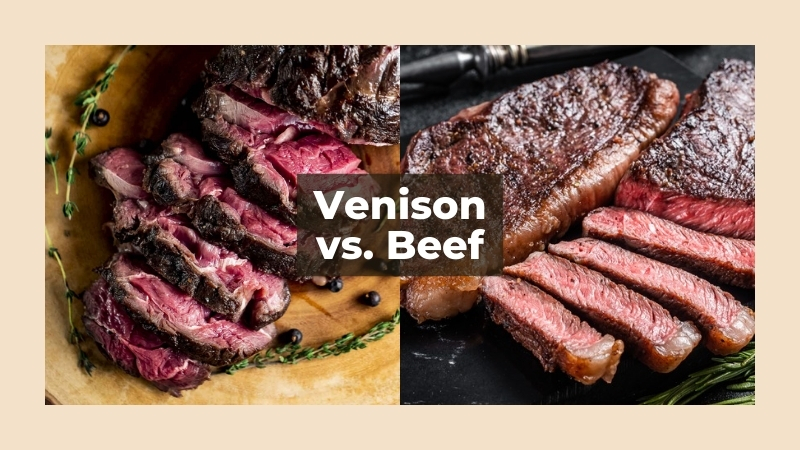The debate between venison and beef comes down to personal preference, but for me, venison is the clear winner in terms of health, sustainability, and unique flavor.
Beef is undeniably delicious—its high-fat content makes it tender, juicy, and easy to cook. It’s the go-to option for a classic steakhouse experience, and its rich, umami-packed flavor is hard to beat.
Venison, on the other hand, is leaner, higher in protein, and packed with iron and essential nutrients. It has a bolder, more complex taste that stands out, especially when paired with the right seasonings. Since deer live in the wild and eat a natural diet, the meat is free from antibiotics and hormones, making it a healthier and more sustainable choice.
Cooking venison requires more attention because it’s easy to overcook due to its low-fat content, but when done right, it’s tender and flavorful. Beef is more forgiving and widely available, making it the more convenient option.
Which Meat is Healthier?
When it comes to nutrition, I always look for high protein, low fat, and nutrient density—which is why venison is my top pick. It’s one of the leanest red meats available, packing more protein per serving than beef while cutting the fat significantly.
Nutrient (Per 100g Serving)
Venison
Beef (Ribeye, Standard Fat Content)
Calories
158
250
Protein
30g
26g
Total Fat
3g
15g
Saturated Fat
1.5g
6g
Iron
4.8mg
2.6mg
Cholesterol
85mg
90mg
Omega-3s
Moderate
Low
What This Means for You
- If you’re trying to eat healthier, lose weight, or build lean muscle, venison is the better choice—it’s lower in fat and higher in protein.
- If you prioritize indulgence and a richer texture, beef wins, thanks to its higher fat content which makes it more tender and flavorful.
- If iron intake matters to you (especially for athletes or those prone to anemia), venison has nearly double the iron of beef.
Taste and Texture
Venison: Wild and Bold
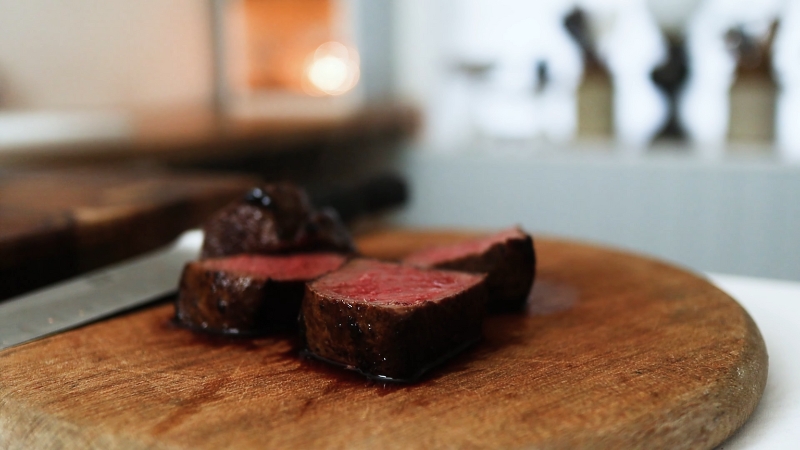
Venison is a true reflection of the wild. Every bite carries the flavors of the forest—earthy, slightly sweet, and intensely rich.
Since deer feed on a natural diet of grasses, berries, nuts, and wild plants, their meat develops a more complex and gamey taste compared to farm-raised beef.
Unlike beef, venison is extremely lean, meaning it lacks the buttery marbling that makes beef melt in your mouth.
This gives it a firmer, more steak-like bite. Because there’s little fat to soften the texture, venison is best when cooked quickly and served medium-rare (130°F-135°F) to keep it tender. Overcooking will dry it out fast.
For those who aren’t used to wild game, venison’s bold flavor might come as a surprise. Some describe it as intensely meaty, while others say it has a sweet, almost herbal taste. It’s a favorite among those who enjoy more robust, savory flavors in their meat.
- Best cuts for rich flavor: Venison loin, backstrap, and tenderloin
- Best cuts for slow cooking: Venison shoulder and shank (great for stews and braises)
- Best cooking methods: Quick sear, sous vide, or slow-braised in flavorful liquids
Beef: Juicy and Classic
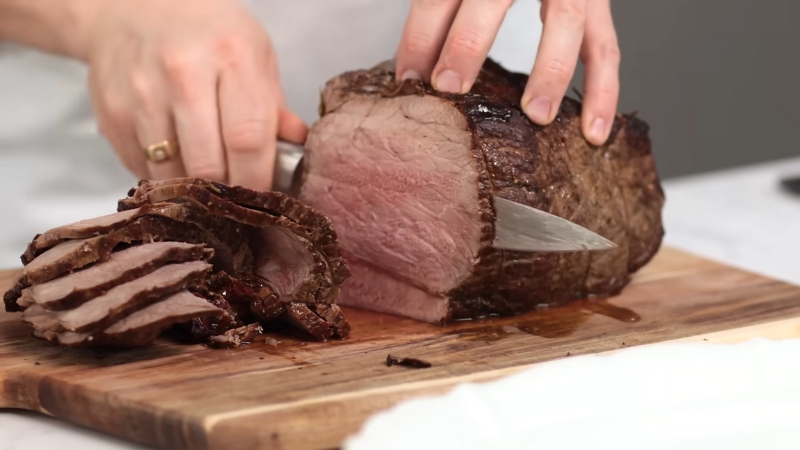
If venison is bold and wild, beef is its luxurious, familiar counterpart. Thanks to its high-fat content and natural marbling, beef is buttery, tender, and packed with umami. A well-cooked ribeye, filet mignon, or New York strip delivers that perfect balance of a crisp, seared crust and a melt-in-your-mouth interior.
Beef’s fat distribution makes it extremely forgiving in the kitchen—it stays juicy even if slightly overcooked, which is why grilled and pan-seared steaks remain a steakhouse favorite. That extra fat also absorbs flavors beautifully, making beef the perfect candidate for rubs, marinades, and bold seasonings.
- Best cuts for ultimate tenderness: Ribeye, filet mignon, wagyu beef
- Best cuts for slow cooking: Chuck roast, brisket, short ribs
- Best cooking methods: Grilling, pan-searing, smoking, slow roasting
Best Recipes & Pairings
Venison Recipe: Pan-Seared Venison Steak with Garlic Butter
A venison steak, when cooked right, is juicy, flavorful, and incredibly tender. The key? High heat, quick cooking, and a little fat.
Ingredients
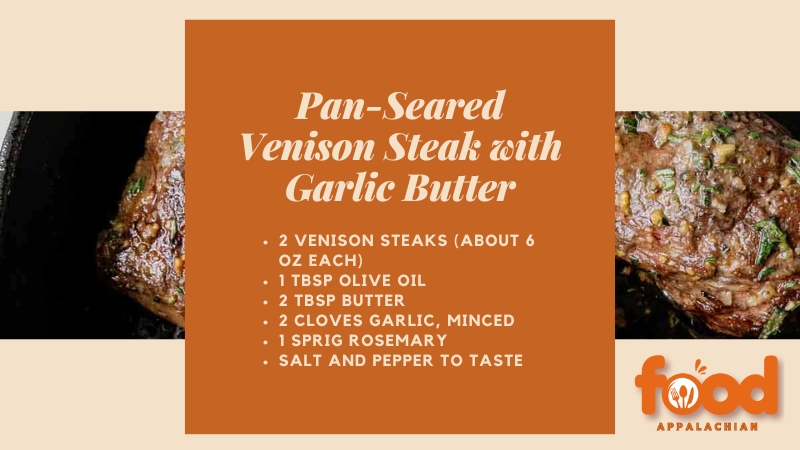
Instructions
- Pat steaks dry and season with salt and pepper.
- Heat olive oil in a pan over high heat.
- Sear steaks for 2-3 minutes per side, until medium-rare (130°F).
- Add butter, garlic, and rosemary. Baste the steaks for 1 minute.
- Remove from heat and rest for 5 minutes before slicing.
View this post on Instagram
Perfect Pairings
- Red wine: A bold Cabernet Sauvignon or Malbec enhances venison’s gamey notes.
- Side dishes: Roasted sweet potatoes, sautéed mushrooms, or a wild rice pilaf.
Beef Recipe: Grilled Ribeye with Herb Butter
A classic ribeye is all about flavor, juiciness, and simplicity. Let the natural richness of the meat shine with this easy recipe.
Ingredients
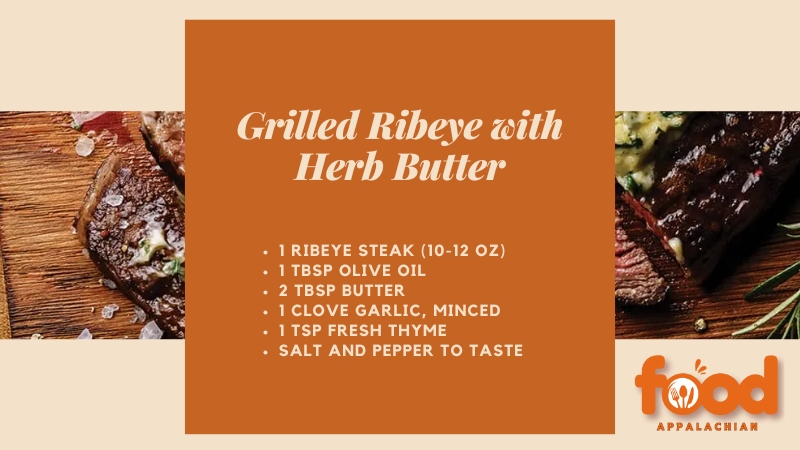
Instructions
- Let the steak sit at room temperature for 30 minutes.
- Preheat grill to high heat (450-500°F).
- Brush steak with olive oil, then season with salt and pepper.
- Grill 4-5 minutes per side for medium-rare (135°F).
- In the last minute, top with butter, garlic, and thyme.
- Rest for 10 minutes before slicing.
Perfect Pairings
- Red wine: A bold Syrah or Merlot pairs perfectly with beef’s fat content.
- Side dishes: Grilled asparagus, mashed potatoes, or a fresh arugula salad.
Bottom Line
If you want a lean, nutrient-dense protein with a rich, natural flavor, venison is the better choice. It is healthier, lower in fat, and more sustainable, making it a great option for those who prioritize clean eating and ethical sourcing.
A venison burger, with its slightly gamey yet rich flavor, makes for a deliciously unique twist on the classic.
If you prefer a more indulgent, buttery texture with deep umami flavors, beef is the clear winner. Its marbling creates a tender, juicy bite, making it ideal for steaks, burgers, and hearty comfort meals.
Why Not Try Both?
The best way to decide is to experience both side by side. Cook a venison steak and a ribeye, season them simply, and compare their flavors and textures.
Whether you enjoy the bold, wild essence of venison or the familiar richness of beef, both offer something unique and delicious.

